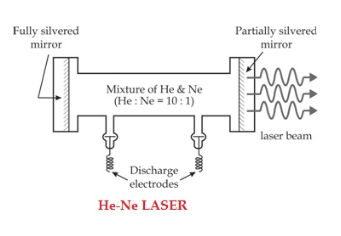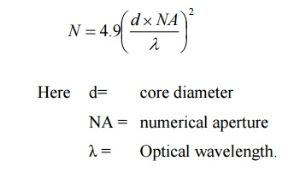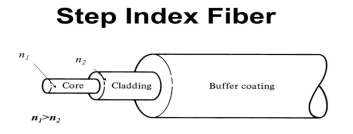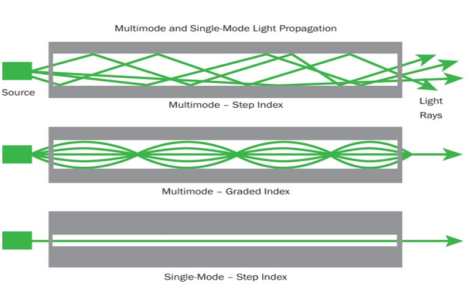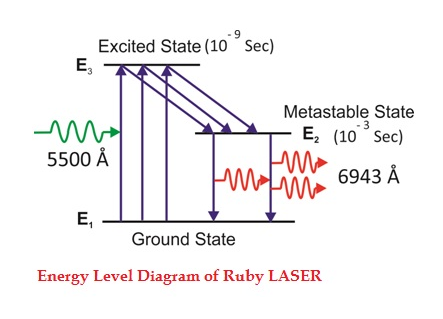Spontaneous emission | Stimulated emission |
1.The spontaneous emission was postulated by Bohr | 1.The stimulated emission was postulated by Einstein |
2. Additional photons are not required in spontaneous emission | 2. Additional photons are required in stimulated emission |
3.One photon is emitted in spontaneous emission | 3.Two photons are emitted in stimulated emission |
4.The emitted radiation is poly-monochromatic | 4.The emitted radiation is monochromatic |
5. The emitted radiation is Incoherent | 5. The emitted radiation is Coherent |
6. The emitted radiation is less intense | 6. The emitted radiation is high intense |
7.The emitted radiation has less directionality | 7.The emitted radiation has high directionality |
8. Example: light from sodium or mercury lamp | 8. Example: light from the laser source.
|
|
|
|
|
|
 (ct-x))Where ‘a’ is the amplitude of the wave and ‘x’ is the displacement of the wave at any instant of time ‘t’.Spatial coherence (or transverse coherence) The predictable correlation of amplitude and phase at one point on the wave train w. r. t another point on a second wave, then the waves are said to be spatial coherence (or transverse coherence)
(ct-x))Where ‘a’ is the amplitude of the wave and ‘x’ is the displacement of the wave at any instant of time ‘t’.Spatial coherence (or transverse coherence) The predictable correlation of amplitude and phase at one point on the wave train w. r. t another point on a second wave, then the waves are said to be spatial coherence (or transverse coherence)
|
 Where r1 and r2 are the radii of laser beam spots at distances of D1 and D2 respectively from the laser source.4. Highly Intense or Brightness We know that the intensity of a wave is the energy per unit time flowing through a unit's normal area. Laser light is highly intense than conventional light. A one mill watt He-Ne laser is highly intense than the sun intensity. This is because of the coherence and directionality of the laser. Suppose when two photons each of amplitude a are in phase with other, then young’s principle of superposition, the resultant amplitude of two photons is 2a and the intensity is 4a2. Since in laser many numbers of photons are in phase with each other, the amplitude of the resulting wave becomes na and hence the intensity of the laser is proportional to n2a2. So 1mW He-Ne laser is highly intense than the sun.In an ordinary light source, the light spreads out uniformly in all directions. If you look at a 100 Watt lamp filament from a distance of 30 cm, the power entering your eye is less than 1/1000 of a watt. If you look at laser beam X (caution: don’t do it at home, direct laser light can damage your eyes) X, then all the power in the laser would enter your eye. Thus, even a 1 Watt laser would appear many thousand times more intense than a 100 Watt ordinary lamp.5. Laser Speckles The term speckle refers to a random granular pattern that can be observed when a highly coherent light beam is diffusely reflected at a surface with a complicated structure. This phenomenon results from the interference of different reflected portions of the incident beam with random relative optical phases.
Where r1 and r2 are the radii of laser beam spots at distances of D1 and D2 respectively from the laser source.4. Highly Intense or Brightness We know that the intensity of a wave is the energy per unit time flowing through a unit's normal area. Laser light is highly intense than conventional light. A one mill watt He-Ne laser is highly intense than the sun intensity. This is because of the coherence and directionality of the laser. Suppose when two photons each of amplitude a are in phase with other, then young’s principle of superposition, the resultant amplitude of two photons is 2a and the intensity is 4a2. Since in laser many numbers of photons are in phase with each other, the amplitude of the resulting wave becomes na and hence the intensity of the laser is proportional to n2a2. So 1mW He-Ne laser is highly intense than the sun.In an ordinary light source, the light spreads out uniformly in all directions. If you look at a 100 Watt lamp filament from a distance of 30 cm, the power entering your eye is less than 1/1000 of a watt. If you look at laser beam X (caution: don’t do it at home, direct laser light can damage your eyes) X, then all the power in the laser would enter your eye. Thus, even a 1 Watt laser would appear many thousand times more intense than a 100 Watt ordinary lamp.5. Laser Speckles The term speckle refers to a random granular pattern that can be observed when a highly coherent light beam is diffusely reflected at a surface with a complicated structure. This phenomenon results from the interference of different reflected portions of the incident beam with random relative optical phases.
|
|
 ………(5)Divide with B21N2 in numerator and denominator in the right side of the above equation,ρ(υ) =
………(5)Divide with B21N2 in numerator and denominator in the right side of the above equation,ρ(υ) =  =
=  ………(6)ρ(υ) =
………(6)ρ(υ) =  =
=  =
= ………(7)We know from Maxwell Boltzmann distribution law
………(7)We know from Maxwell Boltzmann distribution law =
=  ………(8) And also from Planck’s law, the radiation densityρ(υ) =
………(8) And also from Planck’s law, the radiation densityρ(υ) =  ………(9)Comparing the two equations (7) and (9)
………(9)Comparing the two equations (7) and (9) =
= and
and  =1 ………(10)The above relations are referred to as Einstein relations.From the above equation for non-degenerate energy levels, the stimulated emission rate is equal to the stimulated absorption rate at the equilibrium condition.
=1 ………(10)The above relations are referred to as Einstein relations.From the above equation for non-degenerate energy levels, the stimulated emission rate is equal to the stimulated absorption rate at the equilibrium condition. =
=  ………(11)Q5) What is the relationship between B21 and B12?a) B12 > B21
………(11)Q5) What is the relationship between B21 and B12?a) B12 > B21b) B12 < B21
c) B12 = B21
d) No specific relationA 5)C is the correct answer.
B21 is the coefficient for the stimulated emission while B12 is the coefficient for stimulated absorption. Both the processes are mutually reverse processes and their probabilities are equal. Therefore, B12 = B21.Q6) Write Characteristics of Optical Fibre?A 6)
|
|
|
 = 16.02Overall attenuation for 10 km,Attenuation per km = αp (dB/km )=
= 16.02Overall attenuation for 10 km,Attenuation per km = αp (dB/km )=  =
=  = 2.00 dB/km Attenuation in 10 km link = 2.00 x 10 = 20 dBIn 10 km link there will be 9 splices at 1 km interval. Each splices introducing attenuation of 1 dB.Total attenuation = 20 dB + 9 dB = 29 dBQ11) Explain the terms acceptance angle, acceptance cone?A11)Acceptance angle Definition:- Acceptance angle is defined as the maximum angle of incidence at the interface of air medium and core medium for which the light ray enters into the core and travels along with the interface of core and cladding. Let n0 be the refractive indices of airn1 be the refractive indices of coren2 be the refractive indices of cladding
= 2.00 dB/km Attenuation in 10 km link = 2.00 x 10 = 20 dBIn 10 km link there will be 9 splices at 1 km interval. Each splices introducing attenuation of 1 dB.Total attenuation = 20 dB + 9 dB = 29 dBQ11) Explain the terms acceptance angle, acceptance cone?A11)Acceptance angle Definition:- Acceptance angle is defined as the maximum angle of incidence at the interface of air medium and core medium for which the light ray enters into the core and travels along with the interface of core and cladding. Let n0 be the refractive indices of airn1 be the refractive indices of coren2 be the refractive indices of cladding
|
|
|
|
|
|
|
|
|
|
|
|
|

 Q19) A step-index fiber has a core index of refraction of n1 = 1.425. The cut-off angle for light entering the fiber from air is found to be 8.50o. (a) What is the numerical aperture of the fiber? (b) What is the index of refraction of the cladding of this fiber? (c) If the fiber were submersed in water, what would be the new numerical aperture and cut-off angle?
Q19) A step-index fiber has a core index of refraction of n1 = 1.425. The cut-off angle for light entering the fiber from air is found to be 8.50o. (a) What is the numerical aperture of the fiber? (b) What is the index of refraction of the cladding of this fiber? (c) If the fiber were submersed in water, what would be the new numerical aperture and cut-off angle? n22 = n12 - NA2 = (1.425)2 - (0.1479)2 = 2.0088
n2 = 1.417.(c) We know that that the n0 = nwater = 1.33. Since the numerical aperture is a property of the fiber and only depends upon n1 and n2, it will not change when the medium outside the fiber changes. The cut-off angle, however, will have to change if the numerical aperture is to be unaffected by a change in n0: NA = 0.148.
sin θ0max = NA/n0
θ0max = sin-1(NA/n0) = sin-1(0.1479/1.33) = = sin-1(0.1112) = 6.38o.Q20) Let n = 1, n1 = 1.46 and n2 = 1.45 in the diagram of the optical fiber system
|
a) the critical angle θc at the core - cladding interface.
b) the numerical aperture N.A. of the optical fiber
c) the angle of acceptance αmax of the the optical fiber system.
A 20)a) θc = sin-1 (n2 / n1) = sin-1 (1.45 / 1.46) = 83.29 °
b) N.A. = √(n21 - n22) = √(1.462 - 1.452) = 0.17
c) αmax = sin-1√(1.462 - 1.452) = 9.82 ° Q 21) Let n = 1, n1 = 1.46 and n2 = 1.45 in the diagram of the optical fiber
|
a) angle of refraction β at the outside - core interface.
b) angle θ
c) and explain why this light ray will be reflected at the core - cladding interface and hence guided along the fiber.
A 21)a) Angle β is found using Snell's law at the outside - core interface as follows
n sin(α) = n1 sin(β)
Substitute the given parameters from Q 20) to obtain
β = sin-1 ( sin(5°) / n1) = 3.42 °
b) Angle θ is complementary to angle β hence
θ = 90 - 3.42 = 86.58 °
c) The angle of incidence θ = 86.58 ° at the core - cladding interface is larger that the critical angle θc = 83.29 ° calculated in Q 20) above and will therefore be totally reflected at this interface and hence guided along the fiber.
Also angle α = 5° is smaller to αmax = 9.82 ° Q22) Discuss the construction, working, and application of Solid-State Laser? OrDiscuss the construction, working, and application of Ruby Laser?OrDiscuss three-level laser?A 22)Ruby laser Ruby laser is a three-level solid-state laser and was constructed by Maiman in 1960. Ruby laser is one of the few solid-state lasers that produce visible light. It emits deep red light of wavelength 694.3 nm.Construction A ruby laser consists of three important elements: laser medium, the pump source, and the optical resonator.Laser MediumRuby (Al2O3+Cr2O3) is a crystal of Aluminium oxide, in which 0.05% of Al+3 ions are replaced by the Cr+3 ions. The colour of the rod is pink. The active medium or laser medium in the ruby rod is Cr+3 ions. In ruby laser, 4cm length and 5mm diameter rod is generally used. The ruby has good thermal properties.
|
|
A 23)An optical fibre is characterized by one more important parameter, known as V-number which is more generally called normalized frequency of the fibre. It is given by the relation V – number determines how many modes a fibre can support, It is given by, V =
 NAWhere d is the diameter of the core, l is the wavelength of light used NA is the numerical aperture of the fibre.V =
NAWhere d is the diameter of the core, l is the wavelength of light used NA is the numerical aperture of the fibre.V =
 Or V =
Or V =

 If V ≤ 2.405, then the fibre is single mode fibre (SMF) If V > 2.405, then the fibre is multimode fibre (MMF) Q24) Consider a multimode step index fibre with n1 = 1.53 and n2 = 1.50 and λ= 1μm. If the core radius = 50 μm then calculate the normalized frequency of the fibre (V) and the number of guided mode.A 24)d = 2r = 2 x 50 x 10-6 m V =
If V ≤ 2.405, then the fibre is single mode fibre (SMF) If V > 2.405, then the fibre is multimode fibre (MMF) Q24) Consider a multimode step index fibre with n1 = 1.53 and n2 = 1.50 and λ= 1μm. If the core radius = 50 μm then calculate the normalized frequency of the fibre (V) and the number of guided mode.A 24)d = 2r = 2 x 50 x 10-6 m V =  NA =
NA =
 =
= 
 =94.72= normalized frequencyTotal number of guided mode = M = V2/2 = 4486.Q 25) When mean optical power launched into an 8 km length of fibre is 12 μW, the mean optical power at the fibre output is 3 μW. Determine Overall signal attenuation in dB.The overall signal attenuation for a 10 km optical link using the same fibre with splices at 1 km intervals, each giving an attenuation of 1 dB.A 25)Given :z=8kmP(0) = 120 μWP(z) = 3 μWOverall attenuation is given by,αp (dB/km ) = 10. log
=94.72= normalized frequencyTotal number of guided mode = M = V2/2 = 4486.Q 25) When mean optical power launched into an 8 km length of fibre is 12 μW, the mean optical power at the fibre output is 3 μW. Determine Overall signal attenuation in dB.The overall signal attenuation for a 10 km optical link using the same fibre with splices at 1 km intervals, each giving an attenuation of 1 dB.A 25)Given :z=8kmP(0) = 120 μWP(z) = 3 μWOverall attenuation is given by,αp (dB/km ) = 10. log  = 16.02Overall attenuation for 10 km,Attenuation per km = αp (dB/km )=
= 16.02Overall attenuation for 10 km,Attenuation per km = αp (dB/km )=  =
=  = 2.00 dB/km Attenuation in 10 km link = 2.00 x 10 = 20 dBIn 10 km link there will be 9 splices at 1 km interval. Each splices introducing attenuation of 1 dB.Total attenuation = 20 dB + 9 dB = 29 dB
= 2.00 dB/km Attenuation in 10 km link = 2.00 x 10 = 20 dBIn 10 km link there will be 9 splices at 1 km interval. Each splices introducing attenuation of 1 dB.Total attenuation = 20 dB + 9 dB = 29 dB 









